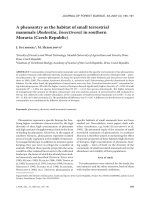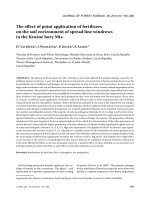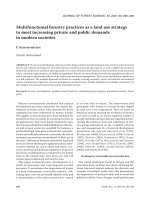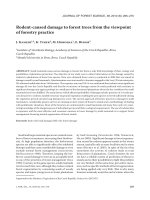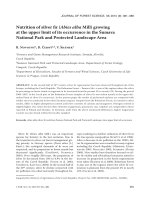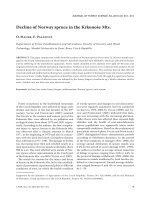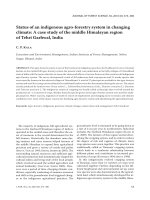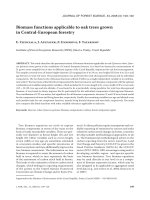Báo cáo lâm nghiệp: "Multifunctional forestry practices as a land use strategy to meet increasing private and public demands in modern societies" ppt
Bạn đang xem bản rút gọn của tài liệu. Xem và tải ngay bản đầy đủ của tài liệu tại đây (212.47 KB, 9 trang )
290 J. FOR. SCI., 53, 2007 (6): 290–298
JOURNAL OF FOREST SCIENCE, 53, 2007 (6): 290–298
Natural environmental conditions and cultural
development processes determine the spatial dis-
tribution of forests and at what intensity the forest
vegetation has been influenced by human activity.
is applies to forests that have been exploited for
hundreds of years as well as to wooded areas that, to
all appearances, have been barely touched by man.
e reasons behind the actual delimitation of the for-
est and of open spaces are manifold: for instance, a
particularly high value given to forests for economic,
social, and cultural reasons or, conversely, the lack of
economic interest that was attributed to their use in
the past. Differences between intensively exploited
areas and those showing few apparent human inter-
ventions depend on social values and needs, eco-
nomic potential and political regulations. In general
all forests, including those considered to be forests
close to the natural state, have been, are, and will
remain spaces influenced and used by man.
This paper analyses forestry development as a
result of successive and superimposed societal
processes. It accentuates the importance of forests
as a local environment, a renewable resource, a lib-
erating space one can personally identify with, and
a representation of the space perceived as natural
or at least close to nature. e observations deal
principally with forests in Central Europe shaped
by man over a very long period. ey are based on
literature sources showing the evolution of forestry
over time as well as on recent empirical studies of
people’s attitudes and perceptions regarding forests.
Among the reference texts and collections of arti-
cles giving information on the condition of forest
use and management in a historical development
perspective, one may cite A et al. (1997),
B (1984), C (1996), C
(1987), D (1965), H (1992), H
(1985), H (1972), H and J
(1994), H (1951), K (1995,
1998), M (1990), S (2003a,
2005a) and S (1991).
Heading for sustainable forest production
e varied landscapes found in Europe and the
successive forms of forest uses observed during dif-
ferent historical periods indicate the diversity and
intensity of multiple needs; they also demonstrate
the importance of spiritual values and of social and
political realities. Some changes resulting from past
Multifunctional forestry practices as a land use strategy
to meet increasing private and public demands
in modern societies
F. S
Zurich, Switzerland
ABSTRACT: e present distribution of forests and the degree of their transformation by man are the results of natural
factors and cultural development. e limit between forested areas and open spaces, as well as differences between
intensively used forests and those showing small or no traces of human intervention, is determined by social needs and
values, economic opportunities, and political regulations. Forests are currently perceived by the population as physical
and social spaces profoundly influenced by timber use and forest management. eir social and political significance
is in full evolution. e multiple demands on forests in a rapidly evolving economic, social, and political environment
require maintaining a high level of forest management standards and a flexible adaptation of multiple-use forestry to
the complex interactions between the private and public sectors.
Keywords: forestry development; multifunctional land use; environmental perception; nontimber benefits; forest
policy
J. FOR. SCI., 53, 2007 (6): 290–298 291
human interventions appeared over a relatively short
period of time, and their consequences for the extent
and composition of forest stands rapidly became
clear. Other changes, often those with the heaviest
impacts, came to light indirectly, and their effects
could be appreciated only after long periods. e
alternating processes of reduction and expansion in
forest cover modified the limits between forests and
open space. In regions under intensive cultivation,
as well as around large towns and in the periurban
space, forests now occupy only a small part of their
initial range. On the other hand, in mountain regions
and in the Alps, the forest has remained or has again
become a primordial element. In these regions it
determines to a considerable extent the economic
and social potential as well as the specificity of the
landscape. The traces of earlier settlements and
abandoned farms reveal the dynamics of needs and
values that determined the actual distribution of
forests.
Manifold uses of the forest have followed and often
superseded each other in the course of centuries.
Forests have been and still are local resources com-
plementary to agricultural and pastoral production,
energy and raw material resources, and the founda-
tion of modern forestry and wood-processing indus-
tries. Use and management of the natural potential
of forests have made possible many economic and
social activities, which in return have shaped the
landscape to a large extent. us, European forests
bear witness to cultural processes and developments,
and they show evidence of the impact of numer-
ous and constantly changing human needs. The
evolution of forest cultivation and sustainable wood
production was dealt with by A (1989),
B (1970, 1987), G (2002), H (1985),
H (1982), M and P (1976),
M (1980, 1990), R (1967), S
(1996), S (1997), S (1977), S
(1993), S (1997), S (1995), S
(1982) and S (1996).
Public provisions referring to forest uses over
more than one generation are probably among the
oldest forms of long-term environmental and natural
resource policy. Customary law, already codified in
the first half of the 14
th
century, regulated forest uses
in accordance with the demands and options of their
times (M 1990). As early as in 1295, a local
rule of Landau (Palatina) provided that wood cut in
the area be available for the local inhabitants. e
Frankenspiegel, which chronicled the laws that were
customary around 1330, stipulated that fellings be
done moderately and without devastation. Similar
principles were expressed later on in the local laws
of many villagers’ associations, convents, municipali-
ties, and towns. Use regulations explicitly prohibited
the felling of fructiferous trees and species that were
important for local wood supply. Forests surround-
ing settlements were intended for local users only
and were subdivided into annual felling units. After
logging, such units were protected against grazing
until regrowth was ensured.
During the 15
th
and 16
th
century, wood supplies
from yet unexploited forests could not meet the
growing needs for domestic fuel, construction, salt
production, and metallurgy any more. An unprece-
dented increase in demand led to high prices for
regionally and internationally traded logs and sawn
timber, with repercussions in many parts of Central
Europe. As a consequence, the essential conditions
for a more stable forest regime were established be-
tween the 17
th
and 19
th
centuries.
Step by step, policy and law introduced principles
of renewable natural resource use as we understand
them today (Z 1965). e term sustainable
was used as early as in 1713 by von Carlowitz, who
worried about maintaining mining activities and
wrote (translation by the author) “e greatest art,
science, diligence and institution of these countries
will rely on the manner in which such conservation
and growing of wood is to be undertaken in order
to have a continuing, stable and sustained utiliza-
tion, as this is an indispensable cause without which
the country in its essence cannot remain.” In 1804,
Georg-Ludwig Hartig formulated the principle of
sustainable forestry in its classic intergenerational
perspective, remarking in his textbook Taxation of
Forests (translation by the author): “It is not pos-
sible to think and expect sustained forestry if the
wood allocation from the forests is not calculated
according to sustainability … Any wise forest direc-
tion consequently needs to tax [assess] the woods
as high as possible, but aiming at using them in a
way that the descendants can draw at least as many
advantages as the now-living generation appropri-
ates.” In 1841, Carl Heyer referred to the techniques
of sustainability of wood production in saying that
a forest is “managed in a sustainable manner if one
takes care of the regeneration of all logged stands in
order to maintain the soil that is destined to forest
production.” By 1850, one could say that most forest
areas had come under some form of long-term forest
production system.
e continuity and increase of wood supply re-
quired considerable private and public efforts and
investment, but that long-term investment could
not be obtained without security of forest tenure.
Establishing the formal aspects of forest ownership
292 J. FOR. SCI., 53, 2007 (6): 290–298
rights is probably the most significant contribution
of forest laws adopted during the 19
th
century. Gen-
erally, the laws tended to restrict or abolish usufruct
rights and transform collective tenure into clearly
defined private and public landownership. Private
property rights were legally registered, and forests
still under collective tenure were divided among the
users. In other cases communal and state forests
were maintained or newly created. Quite often a
combination of private and public tenures deve-
loped, characteristic of the prevailing ownership of
forests in most European countries. e laws defined
the landowner’s wood production and management
rights in using the forest as a productive asset for
generating profit and income. ey also determined
responsibility for maintaining collective uses in the
public interest, such as access to forests and protec-
tive values in the mountains, which were important
to a large part of the population.
e transitions to dependence for energy on min-
eral coal in the 19
th
century and fossil fuel in the
20
th
century had major consequences. e diminish-
ing pressure on wood as an energy source radically
modified the conditions under which forests would
be used for the industrial and economic expansion of
a country. is has been a decisive element in turn-
ing forestry into a modern sector of the economy,
functioning according to the principle of sustain-
able management of a renewable resource. The
methods for putting sustainable wood production
into practice developed from scientific models that
allowed the intensity of felling to be adjusted to the
long-term production potential of forest stands and
sites. ese models were applied over increasingly
large areas. In regions where oak and beech forests
dominated, the coppice-with-standards system was
a typical example of systematic management on a
large scale. is approach combined production of
firewood from new sprout shoots with production
of construction timber from trees retained over
several cycles of firewood harvests. e coppice-
with-standards silvicultural system, developed in the
16
th
century, still constitutes an important method
of management and is used, for instance, in France.
In contrast, numerous forests in Germany and Swit-
zerland where the system was once practised were
converted into high forest from the middle of the
19
th
century onward.
More important, however, was the regeneration
of forests over large areas and the management of
uniform stands. In the plains and foothills, the in-
troduction of sustainable wood production during
the 19
th
century quite often favoured stands with
predetermined periods of rotation, allowing regene-
ration of clearcut areas. Seeding of conifers and large
plantations of spruce or pine permitted the affores-
tation of exploited and devastated surfaces where
natural regeneration was difficult. In general, coni-
fers were systematically favoured because the thin-
ning and final felling of even-aged stands allowed a
rapid increase in wood production to meet economic
demands. In the Alps and, to a lesser extent, in other
mountains of Central Europe, the practice of selec-
tive logging was combined with natural regeneration.
Today these practices have evolved toward various
forms of silviculture that are “close to nature,” such
as selection forests.
Multiple private and public demands
towards forests in modern societies
What forests mean at the present time to the
population, landowners, and specific user groups
has become an interesting and topical subject of re-
search (B 2000; C et al. 1997; K,
P 1979). Empirical investigations of the
perceptions and attitudes of people regarding for-
ests and forest management reveal the evolution of
forests’ social significance. Researchers have studied
the perceptions and attitudes of the population at the
national, regional, and local scales (J, K
2000; O, R 1995; R 1999; SAEFL
2000; S, K 1995; W-E
2002; W-E, Z 2000; Z-
et al. 1996). Other studies deal more specifi-
cally with the expectations and behaviour of visitors
to forests reserved for leisure and recreation (E-
1996; K 1981; L 1980; N
1992; S, W-E 2000). On the
whole, the studies analyzing the attitudes and pur-
poses of citizens, owners, and users of forested areas
have begun to influence management and politics
(J, K 1995; J 1993; R 1998;
S et al. 1997; T 1998).
e findings confirm, first of all, that the forest
remains a usable and productive part of man’s envi-
ronment for most people and that its management
is notably conditioned by economic preferences. If
wood formerly constituted an indispensable source
of energy and a major construction material, it is now
replaceable, from a technological point of view, with
fossil fuels and alternative materials. Its use depends
on how it compares in national and international com-
petition. However, because it is a renewable resource
with a largely neutral carbon dioxide production cycle,
today wood production is also an essential political
option in the context of protecting the environment
and addressing climate change problems.
J. FOR. SCI., 53, 2007 (6): 290–298 293
e results of the empirical studies show further
that forests have acquired a new and more global
meaning in modern society, going beyond their role
as a productive and usable resource. For a growing
part of the population, forests represent a space ac-
cessible to the public for recreation that is different
from the other transformed areas. At the same time,
forests are more and more identified as a natural
environment, perceived by many people to have
small or no human influence. ey represent the free
interplay of natural forces, in contrast to inhabited
and intensively cultivated areas. is new develop-
ment reflects the needs and preferences of contem-
porary society and the desire of an increasing urban
population for recreation in natural surroundings.
It also reflects people’s concern over the impending
threats to the environment and biodiversity and their
sensitivity to global phenomena. And it reflects the
individual values of many people for whom the for-
est represents a place for meditation, reflection, and
freedom. e wish to preserve the forest, a symbol
of nature, is expressed in demands for limiting for-
est exploitation and protecting areas in a close-to-
natural state. For many people, the protection of
environment and landscape has become a major
criterion for judging overall performance in forest
management.
e surveys confirm the importance of the social
amenities provided by urban forests and two im-
portant perspectives on green spaces within and
around towns: first, forests suffer less from outside
influences and can counterbalance and compensate
for intensively developed areas, and second, forests
offer a space permitting a greater liberty of move-
ment and more spontaneous activities than the
other parts of urban landscape. e motivations
of survey respondents vary according to individual
preferences and their social and economic status, but
many emphasize that the forest is a place where one
may walk, practise various sports, study nature, or
breathe and relax; it is also a place where one feels
happy and can rest from daily stress. e responses
underline the importance of the forest as a place
where one can withdraw and express one’s love of
nature, as a quiet place for personal reflection, and
as a realm of physical and emotional sensations. Al-
though visitors to the forest come for many reasons,
the significance of emotional, spiritual, and mystical
values is growing.
In Switzerland the mountain forest is considered
by almost everyone as a natural area and an ele-
ment in environmental protection (S
et al. 2000a). To the same extent, it is considered a
place for recreation, an element of the landscape,
and a renewable resource for wood production.
e respondents say that the importance of forests
as a natural environment and an accessible place
of freedom determines the priorities they give to
management and forestry activities. Silvicultural
care and regeneration, as well as repairing damage
caused by natural disasters, are considered by more
than 90 percent of respondents as important or very
important. Activities aiming to protect or restore
flora or fauna receive the same high priority.
e available information highlights the often con-
tradictory expectations and demands surrounding
forests and forestry management. For town dwellers
the forest represents, above all, a favoured area for
leisure and relaxation. Inhabitants of mountain re-
gions see it as protection against natural dangers and
as a tourist attraction. Forest owners, farmers, and
industry see it primarily as a source of revenue from
harvesting wood. For one part of the population the
forests are unique, and the necessity of conserving
them predominates. Another part considers the
economic aspects of wood production providing em-
ployment and a source of revenue most important. If
the conflicts generated by land use were previously
at the fore, today the very purpose of the forest is at
the core of debates about man’s relationship with his
environment (S et al. 2000b, 2005b).
e fundamental concepts of forest management
are now the subject of political debates and of the
rapidly changing legislation. In the face of ever-more
pressing demands for environmental protection and
conservation of biodiversity on a large scale, it is not
the principle of sustainable wood production that
is in question but certain forestry practices judged
incompatible with sustainable development. From
this point of view, a forest economy capable of tak-
ing into account profound currents of opinion in our
society will benefit from the approval and acceptance
of the population.
Multifunctional forestry practices as a land use
strategy to meet increasing societal demands
Sustainable development starts from the principle
that the present level of consumption and its effects
on the environment must respect an equilibrium
that makes the necessary space for manoeuvring for
future options. A sustainable use of natural resources
is thus linked to concrete economic and technical
conditions and depends on fundamental human per-
spectives and social norms at the same time. Sustain-
ability does not express an intention for the use of
resources; it rather represents what people and social
and political communities recognize as worth saving
294 J. FOR. SCI., 53, 2007 (6): 290–298
and managing responsibly. Openness and flexibility
in reacting to changing societal needs and values,
understanding of the ecological, social and economic
drivers determining their political relevance, and
transparency in negotiations and decision making
are the necessary ingredients in managing renewable
natural resources in a sustainable way.
In this context one has to judge the importance
of multifunctional forest management practices as
a land use strategy capable of meeting divergent
societal interests, supporting forestry practices ac-
ceptable to different social groups, and remaining
consistent with the principles of sustainable develop-
ment. Rational and economically feasible wood pro-
duction remains the prerequisite for an expanding
European wood-processing sector. anks to new
production technologies, the sector competitive-
ness in world markets increases. Wood production
and the use of wood products imply a largely neutral
production and consumption cycle with regard to
emissions of carbon dioxide. Expanding the forest
and wood product sector is an essential option in
the context of environmental protection, climate
change, and maintenance of the renewable resource
base (T et al. 2004). Accumulating additional
biomass under good forestry practices and by affor-
estation is an important political requirement for
implementing the Kyoto Protocol.
e meaning of sustainable forest management
thus expands from its primary focus on wood pro-
duction to include a wide range of different com-
binations of forest uses meeting economic needs
and opportunities as well as addressing dynamically
changing social and cultural values (S,
S 2006). In a modern business management-
oriented definition, as formulated by S (1984),
sustainable forestry means the ability of landowners
and forest enterprises to produce wood, to care for
infrastructural services, and to provide environ-
mental services for the benefit of present and future
generations. It means maintaining and creating the
entrepreneurial conditions necessary for a perma-
nent and continually optimal fulfilment of economic
and extraeconomic needs and goals. Sustainable
forestry addresses the time perspective (permanent
and continuing), the kinds of activities (maintaining
and creating), the objectives (needs and goals), and
the qualifying criteria (optimal fulfilment).
Management practices that correspond to the
needs and values of modern societies take into ac-
count the forest as a multifunctional resource, the
specificity of a wide range of ecosystems, the need to
maintain biodiversity, and the economic and social
development potential of forests in rural and urban
areas (B et al. 2004; B, S
2005). e issues at stake are meeting local, national,
and increasingly international environmental de-
mands, securing the long-term availability of raw
materials and energy, and providing specific com-
binations of goods and services commensurate with
the sustainable resource potential of a given forest
site. Close-to-nature forestry practices are an impor-
tant land management strategy that contributes to
maintaining biodiversity, ecosystems and diversified
landscapes. It favours flexible and long-term produc-
tion cycles, offers attractive areas for recreation and
leisure activities, and leaves options for future uses
and developments. In relying on natural site fac-
tors, close-to-nature forestry combines economic
necessities with multiple social and environmental
requirements more consistently than do other man-
agement approaches.
e increasing private and public demands for
forest protection and management make it neces-
sary to redefine the roles of the private and public
sectors, to use economic models taking into con-
sideration multiple outputs from forestland, and to
develop an equitable and effective balance between
management responsibilities and the benefits that
accrue to the stakeholders (L et al. 2005; L
M et al. 2005). Cross-sector policy linkages
and multisector policy networks are an indispensa-
ble requirement for managing forest ecosystems and
landscapes in a sustainable manner (FAO 2002, 2003;
S 2003b). Private enterprise and public
policies, as much as private and public investment,
need to be coordinated so that natural resources are
used more efficiently on a landscape scale.
Multifunctional management of forests on a land-
scape scale facilitates decision-making processes
and provides a political platform for arbitration and
conflict resolution between the demands of land-
owners and forest managers on the one side, and
the wide spectrum of demands from other forest
users and environmental groups on the other side.
Multifunctionality as a leading principle in for-
estry development implies a combination of private
management goals with public policy objectives,
acknowledges the necessity of balancing private
and public interests, and fosters the elaboration of
workable arrangements for landowners facing public
demands. It allows for realistic financial arrange-
ments to provide a wide range of forestry outputs
based on forest owners’ income from goods and
services, contractual financial contributions from
specific user groups, and public compensations and
investments made at different levels of the political
community. e recognition of joint management
J. FOR. SCI., 53, 2007 (6): 290–298 295
responsibilities between the private and the public
sector requires a shift from governmental and hier-
archical regulatory systems to negotiations among
stakeholders with complementary and/or conflicting
societal needs and values.
CONCLUSIONS
During the last two centuries sustainable forest
management has made great progress, thanks to the
efforts of forest owners, professionals, and scientists.
Step by step, it has integrated increasing societal de-
mands into current management practices. To assess
the present and future options in management of
forests, one has to be aware of the historical context.
Shaped by the past, today’s forest stands offer mul-
tiple alternatives for satisfying economic and social
demands, and multifunctional management will
allow further options and a different development
potential for future generations. e knowledge of
how the modern forest economy evolved, focusing
primarily on sustainable wood production, quite of-
ten contrasts with the significance our largely urban
population places on the forest of today. It is essential
to understand today’s needs and values and to grasp
the economic utility and social significance of forests
in modern societies.
Public intervention implies a complex balance be-
tween political objectives and instruments, between
desired benefits and the necessary financial resour-
ces to obtain them, and between the mix of desired
forestry outputs and possible cost-sharing arrange-
ments to produce them. New ways of implementing
public policy programmes based on target-oriented
outputs and contractual arrangements are necessary
to improve the efficiency of the public sector and
to link commitments and required resources more
consistently. e diversification of demands on for-
ests, profound changes in the relationship between
the government and citizens as well as structural
limitations on financial resources are decisive factors
that determine the range of possible management
options. Cooperation and coordination between
key actors and institutions in public policy, as well
as a rational basis for using scarce public funds to
foster multifunctional forest resource development,
are essential.
Marketable products and services can be financed
from market proceeds. Public goods and services
for which no markets exist or for which none can be
developed, for whatever reasons, need public invest-
ment or must be financed by the direct beneficiaries.
Democratic decision making and equal considera-
tion of economic, social, and environmental goals
determine the modern institutional framework for
forest protection and forestry development. e
level of integration between environmental, social
and cultural requirements and efficient economic
productions processes is the benchmark for modern
forestry. Legal and economic instruments balancing
rights and responsibilities between forest owners
and other stakeholders interested in sustainable land
management are indispensable for generating an
optimal combination of private and public benefits
from adaptive multifunctional forest management
practices.
R efere n c e s
ALLMANN J., 1989. Der Wald in der frühen Neuzeit. Eine
mentalitäts- und sozialgeschichtliche Untersuchung am
Beispiel des Pfälzer Raumes 1500–1800. Schriften zur
Wirtschafts- und Sozialgeschichte 36. Berlin, Duncker und
Humblot: 416.
ARNOULD P., HOTYAT M., SIMON L., 1997. Les forêts
d’Europe. Collection fac. géographie. Paris, Edition Nathan:
413.
BAUER J., KNIIVILÄ M., SCHMITHÜSEN F., 2004. Forest Legis-
lation in Europe: How 23 Countries Approach the Obligation to
Reforest, Public Access and Use of Non-Wood Forest Products.
Geneva Timber and Forest Discussion Papers, ECE/£TIM/
DP/37. United Nations, New York and Geneva: 36.
BECHMANN R., 1984. Des arbres et des hommes – La forêt
au Moyen-Age. Paris, Flammarion: 385.
BOURIAUD L., SCHMITHÜSEN F., 2005. Allocation of
property rights on forests through ownership reform and
forest policies in Central and Eastern European countries.
Schweizerische Zeitschrift für Forstwesen, 156: 297–305.
BRANDL H., 1970. Der Stadwald von Freiburg. Eine forst-
und wirtschaftsgeschichtliche Untersuchung über die
Beziehungen zwischen Waldnutzung und wirtschaftlicher
Entwicklung der Stadt Freiburg vom Mittelalter bis zur
Gegenwart. Freiburg Brsg., Poppen & Ortmann: 258.
BRANDL H., 1987. Zur Geschichte der Wirtschaftlichkeit in
der Forstwirtschaft. AFZ, 42: 1019–1023.
BRAUN A., 2000. Wahrnehmung von Wald und Natur. Op-
laden, Leske und Budrich.
CARLOWITZ H.C. von, 1713. Sylvicultura Oeconomica oder
Hausswirthliche Nachricht und Naturgemässe Anweisung
zur Wilden Baum-Zucht. Leibzig.
CAVACIOCCHI S., 1996. L’uome et la foresta, Secc. XIII–
XVIII. Atti delle Settimane di Studi 27, Instituti Interna-
tionale di Storia Economica F. Datini, Firenze, Le Monnier
– with numerous contributions in English, French and
German: 1234.
CORVOL A., 1987. L’homme aux bois – Histoire des rela-
tions de l’homme et de la forêt, XVII°–XX° siècle. Paris,
Fayard: 585.
296 J. FOR. SCI., 53, 2007 (6): 290–298
CORVOL A., ARNOULD P., HOTYAT M., 1997. La Forêt:
perceptions et représentations. Paris, Editions l’Harmattan:
401.
DEVÈZE M., 1965. Histoire des forêts. Paris, Presses Univer-
sitaires de France: 128.
ELSASSER P., 1996. Struktur, Besuchsmotive und Erwar-
tungen von Waldbesuchern – Eine empirische Studie
in der Region Hamburg (Vol. 1). Hamburg, Institut für
Ökonomie der Bundesforschungsanstalt für Forst- und
Holzwirtschaft.
FAO, 2002. Law and Sustainable Development since Rio: Legal
Trends in Agriculture and Natural Resource Management.
Legislative Study 73, FAO, Rome: 374.
FAO, 2003. Cross-sectoral Policy Impacts between Forestry
and other Sectors. Forestry Paper 142, FAO, Rome: 159.
GREWE B.S., 2002. Der versperrte Wald-Vorindustriel-
ler Waldressourcen-mangel am Beispiel der bayerischen
Rheinpfalz 1814–1870. [Dissertation.] Universität Trier.
HARRISON R.P., 1992. Forests – e Shadow of Civilisation.
Chicago, London, e University of Chicago Press.
HARTIG G.L., 1804. Anweisung zur Taxation und Beschrei-
gung der Forste. Giessen, Darmstadt.
HASEL K., 1985. Forstgeschichte – Ein Grundriss für Studium
und Praxis. Hamburg, Berlin, Parey: 258.
HAUSER A., 1972. Wald und Feld in der alten Schweiz. [422 S.
und Bildanhang.] Zürich, München, Artemis.
HAUSRATH H., 1982. Geschichte des deutschen Waldbaus
– Von seinen Anfängen bis 1850. SchrR. Institut für Forst-
politik und Raumordnung, Universität Freiburg, Freiburg
Brsg.: 416.
HEYER C.G., 1841. Die Waldertrags-Regelung. Giessen.
HILLGARTER F.W., JOHANN E., 1994. Österreichs Wald
– Vom Urwald zur Waldwirtschaft. 2. völlig überarb. und
erweiterte Auflage. Wien, Eigenverlag Autorengemein-
schaft: 544.
HORNSTEIN F. von, 1951. Wald und Mensch – Waldge-
schichte des Alpenvorlandes Deutschlands, Österreichs und
der Schweiz. [Reprint 1984.] Ravensburg, Maier: 283.
JACOBSEN C.H., KOCH N.E., 1995. Summary Report on
Ongoing Research on Public Perceptions and Attitudes on
Forestry in Europe (Summary Report). Horsholm, Danish
Forest and Landscape Research Institute.
JENSEN F.S., 1993. Landscape Managers’ and Politicians’
Perception of the Forest and Landscape Preferences of the
Population. Forest and Landscape Research, 1: 79–93.
JENSEN F.S., KOCH N.E., 2000. Measuring Forest Preferences
of the Population – A Danish Approach. Swiss Forestry
Journal, 151: 11–16.
KALAORA B., 1981. Le musée vert ou le tourisme en
forêt – Naissance et développement d’un loisir urbain,
le cas de la forêt de Fontaineblau. Editions Anthro-
pos: 304.
KALAORA B., POUPARDIN E., 1979. La forêt et la ville
– Essai sur la forêt dans l’environnement urbain et in-
dustriel. Paris, INRA, station de recherche sur la forêt et
l’environnement.
KÜSTER H., 1995. Geschichte der Landschaft in Mitteleuropa.
München, Beck: 424.
KÜSTER H., 1998. Geschichte des Waldes – Von der Urzeit
bis zur Gegenwart. München, Beck: 267.
LAZDINIS M., CARVER A., SCHMITHÜSEN F., TÖNIS-
SON K., VILKRISTE L., 2005. Forest Sector Concerns in
the Baltic States – Implications for an Expanded European
Union. Society and Natural Resources, 18: 839–848.
LE MASTER D.C., SAMPLE V.A., SCHMITHÜSEN F., SEDJO
R.A., 2005. Economic Models of Forest Management, Mul-
tiple Use, and Sustainability. Working Paper, International
Series 05/7. Zurich, Forest Policy and Economics, Depart-
ment of Environmental Sciences, Swiss Federal Institute of
Technology, ETH: 22.
LOESCH G., 1980. Typologie der Waldbesucher – Betrach-
tung eines Bevölkerungsquerschnitts nach dem Besuchs-
verhalten, der Besuchsmotivation und der Einstellung
gegenüber Wald. [Dissertation.] Universität Göttingen.
MANTEL K., 1980. Forstgeschichte des 16. Jahrhunderts
unter dem Einfluss der Forstordnungen und Noe Meurers.
Berlin, Parey: 1071, 32 Abb.
MANTEL K., 1990. Wald und Forst in der Geschichte – Ein
Lehr- und Handbuch. Mit einem Vorwort von Helmut
Brandl. Nach dem Tode des Verfassers für den Druck bearbei-
tet von Dorothea Hauff. Alfeld-Hannover, Schaper: 518.
MANTEL K., PACHER J., 1976. Forstliche Biographien vom
14. Jahrhundert bis zur Gegenwart-Zugleich eine Ein-
führung in die forstliche Literaturgeschichte. Hannover,
Schaper: 441.
NIELSEN C., 1992. Der Wert stadtnaher Wälder als Erho-
lungsraum – Eine ökonomische Analyse am Beispiel von
Lugano. Chur, Rüegger.
OESTEN G., ROEDER A., 1995. Wertschätzung des Pfälz-
erwaldes. Allgemeine Forstzeitschrift, 50: 105–107.
ROCEK I., 1998. Les attitudes des habitants de la République
Tchèque envers la forêt et la gestion forestière. Document
de travail, Série internationale 98/3. Chaire de politique
et économie forestière, Ecole polytechnique fédérale de
Zurich.
ROCEK I., 1999. Les opinions des propriétaires forestiers
– Résultats d’une enquête en République Tchèque. Docu-
ment de travail, Série internationale. Chair de politique
et économie forestière, Ecole polytechnique fédérale de
Zurich.
RUBNER H., 1967. Forstgeschichte im Zeitalter der industriel-
len Revolution. Berlin, Duncker und Humblot: 235.
SAEFL 2000. Social demands on the Swiss Forest – Results of
an opinion poll 1998. Swiss Agency for the Environment,
Forests and Landscape, Berne (Environmental Series, No.
309): 129.
SCHENK W., 1996. Waldnutzung, Waldzustand und re-
gionale Entwicklung in vorindustrieller Zeit im mittleren
J. FOR. SCI., 53, 2007 (6): 290–298 297
Deutschland. Historisch-geographische Beiträge zur Er-
forschung von Kulturlandschaften in Mainfranken und
Nordhessen. Erdkundliches Wissen Heft 117. Stuttgart,
Steiner: 325.
SCHMIDT U.E., 1997. Das Problem der Ressourcenknappheit
– dargestellt am Beispiel der Waldressourcenknappheit in
Deutschland im 18. und 19. Jahrhundert – eine historisch-
politische Analyse. [Habil Schrift Forstw. Fak.] Universität
München: 434.
SCHMITHÜSEN F., KAZEMI Y., 1995. Analyse des rapports
entre les attitudes des gens envers la forêt et leurs attitudes
envers la gestion forestière. Schweizerische Zeitschrift für
Forstwesen, 146: 247–264.
SCHMITHÜSEN F., WILD-ECK S., 2000. Uses and percep-
tions of forests by people living in urban areas – findings
from selected empirical studies. Forstwissenschaftliches
Centralblatt, 119: 395–408.
SCHMITHÜSEN F., KAZEMI Y., SEELAND K., 1997. Percep-
tions and attitudes of the population towards forests and
their social benefits – Social origins and research topics of
studies conducted in Germany, Austria and Switzerland
between 1960 and 1995. International Union of Forest Re-
search Organizations (IUFRO), Vienna, IUFRO Occasional
Paper, 7: 1–30.
SCHMITHÜSEN F., WILD-ECK S., ZIMMERMANN W.,
2000a. Einstellungen und Zukunfstperspektiven der Be-
völkerung des Berggebietes zum Wald und zur Forstwirt-
schaft. Beiheft Nr. 89, Schweizerischen Zeitschrift für
Forstwesen: 197.
SCHMITHÜSEN F., HERBST P., LE MASTER D.C. (eds.),
2000b. Forging a New Framework for Sustainable Forestry:
Recent Developments in European Forest Law. IUFRO
World Series Volume 10. IUFRO Secretariat, Vienna: 354.
SCHMITHÜSEN F., 2003a. Primeval Forests and Forest Cul-
ture – Sustainable Development Opportunities. Prague,
Czech University of Agriculture: 27. (in Czech)
SCHMITHÜSEN F., 2003b. Understanding Cross-sectoral
Policy Impacts – Policy and Legal Aspects. FAO Forestry
Paper FAO, Rome, 142: 5–44.
SCHMITHÜSEN F., 2005a. Forest, Landscape and Society:
an Overview of European Forestry Development. Working
Paper, International Series O5/1; Forest Policy and Forest
Economics, Department Environmental Sciences. Zurich,
Swiss Federal Institute of Technology, ETH: 32.
SCHMITHÜSEN F., 2005b. e Role of Forest Policy and
Law in Maintaining the Natural Resource Base. In: Future-
oriented Concepts, Tools and Methods for Forest Manage-
ment and Forest Research – Crossing European Borders.
Stuttgart, Ulmer, Forstwissenschaftliche Beiträge arandt,
Nr. 28: 157–170.
SCHMITHÜSEN F., SEELAND K., 2006. European Land-
scapes and Forest as Representation of Culture. In: Cultural
Heritage and Sustainable Forest Management – e Role
of Traditional Knowledge. Ministerial Conference on the
Protection of Forests in Europe, Liaison Unit, Warsaw, 1:
217–224.
SCHULER A., 1977. Forstgeschichte des Höhronen. Stäfa,
Gut & Co. Verlag: 180.
SEELAND K., 1993. Der Wald als Kulturphänomen – Von
der Mythodogie zum Wirtschaftsobjekt. Arbeitsberichte,
Allgemeine Reihe 93/3, Professur Forstpolitik und Forst-
ökonomie ETH Zürich.
SELING I., 1997. Die Dauerwaldbewegung in den Jahren
zwischen 1880 und 1930. Eine sozialhistorische Analyse.
Schriften aus dem Institut für Forstökonomie der Univer-
sität Freiburg, Bd. 8, Freiburg Brsg: 128.
SELTER B., 1995. Waldnutzung und ländliche Gesellschaft
– Landwirtschaftlicher “Nährwald” und neue Holzöko-
nomie im Sauerland des 18. und 19. Jahrhunderts. Pader-
born, Schöningh: 482.
SEMMLER J. (Hg.), 1991. Der Wald in Mittelalter und Renais-
sance. Düsseldorf, Droste: 239.
SIEFERLE R.P., 1982. Der unterirdische Wald – Energiekrise
und Industrielle Revolution. München, Beck: 283.
SPEIDEL G., 1984. Forstliche Betriebswirtschaftslehre.
2
nd
ed. Hamburg and Berlin, Paul Parey.
STUBER M., 1996. “Wir halten eine fetter Mahlzeit, denn mit
dem Ei verzehren wir die Henne” – Konzepte nachhaltiger
Waldnutzung im Kanton Bern 1750–1880. [Dissertation
Universität Bern.] Beiheft zur Schweizerische Zeitschrift
für Forstwensen, Nr. 82: 275.
TERRASSON D. (ed.), 1998. Public Perception and Attitudes
of Forest Owners towards Forest in Europe. Perception pub-
lique et attitudes des propriétaires envers la forêt en Europe.
Commentaires et synthèse du groupe de travail COST E 3
– WGI – 1994–1998. CEMAGREF Editions, Antony: 243.
THOROE C., PECK T., GUARIN CORREDOR H., SCHMIT-
HÜSEN F., 2004. e Policy Context of the European Forest
Sector. Geneva Timber and Forest Discussion Papers, ECE/
TIM/DP/34. New York, Geneva, United Nations: 109.
WILD-ECK S., 2002. Statt Wald – Lebensqualität in der Stadt.
Bedeutung naturräumlicher Elemente am Beispiel der Stadt
Zürich. Zürich, Seismo Verlag: 454.
WILD-ECK S., ZIMMERMANN W., 2000. COST- und Moni-
toring-Projekt: Zwei neue forstliche Meinungsumfragen
im Vergleich. Schweizerische Zeitschrift für Forstwesen,
151: 1–10.
ZIMMERMANN W., WILD-ECK S., SCHMITHÜSEN F.,
1996. Einstellung der Bergbevölkerung zu Wald, Forstwirt-
schaft und Forstpolitik. Schweizerische Zeitschrift für
Forstwesen, 147: 727–747.
ZÜRCHER H.U., 1965. Die Idee der Nachhaltigkeit unter
spezieller Berücksichtigung der Gesichtspunkte der For-
steinrichtung. Mitteilungen der Schweizerischen Anstalt
für das forstliche Versuchswesen. Band 41, Heft 4. Zürich.
Received for publication January 2, 2007
Accepted after corrections February 2, 2007
298 J. FOR. SCI., 53, 2007 (6): 290–298
Polyfunkční lesnická praxe jako strategie využití krajiny pro uspokojení
rostoucích potřeb veřejnosti v moderní společnosti
ABSTRAKT: Současné rozmístění lesů a úroveň jejich změn způsobených člověkem jsou výsledkem přírodních
faktorů a kulturního vývoje. Hranice mezi zalesněnými a nezalesněnými oblastmi stejně jako rozdíly mezi intenzivně
obhospodařovanými lesy a lesy s malými nebo žádnými stopami lidského zásahu jsou určovány společenskými potře-
bami a hodnotami, ekonomickými příležitostmi a politickými regulacemi. Lesy jsou v současné době chápány lidmi
jako fyzický a sociální prostor, podstatně ovlivněný využíváním dřeva a lesním hospodářstvím. Jejich společenský
a politický význam se rychle vyvíjí. Polyfunkční požadavky na lesy v rychle se vyvíjejícím ekonomickém, sociálním
a politickém prostředí vyžadují udržování vysoké úrovně a pružnou adaptaci polyfunkčního lesního hospodářství
na složité vztahy mezi soukromým a veřejným sektorem.
Klíčová slova: vývoj lesního hospodářství; polyfunkční využívání krajiny; environmentální pojetí; nedřevní užitky;
lesnická politika
Corresponding author:
Prof. Dr. F S, Vogtsrain 43, 8049 Zurich, Switzerland
tel., fax: +41 44 341 4292, e-mail:
